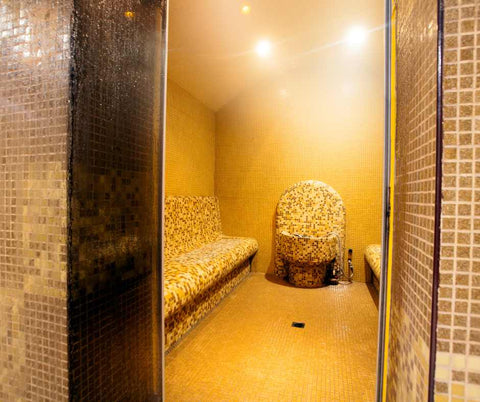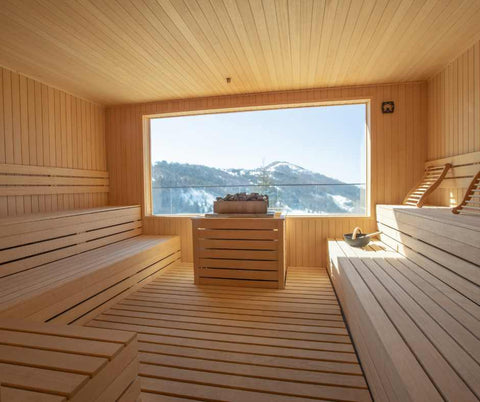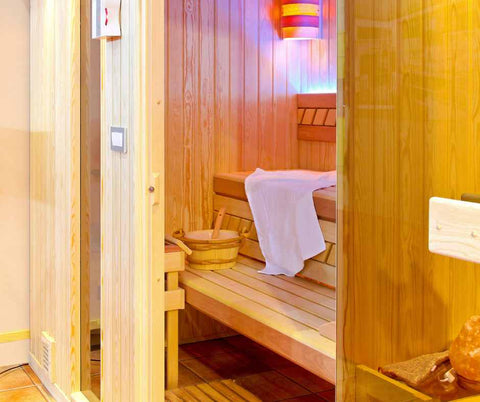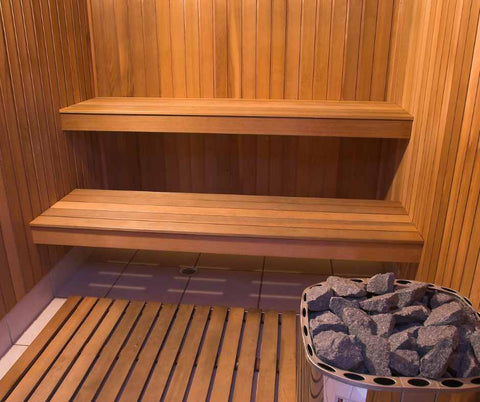Steam Room vs Sauna: Which One Should You Choose for Relaxation and Detoxification?
When it comes to relaxation and detoxification, two popular choices often come to mind: steam rooms and saunas. While both offer a warm, inviting environment to unwind and rejuvenate, they differ in their methods of delivering heat and humidity. Understanding the key differences between steam rooms and saunas is imperative for making an informed decision about which one best suits your needs and preferences.
In this article, we'll learn more about a traditional sauna and steam room, exploring their distinct features, potential health benefits, and how to use them safely and effectively. By the end, you'll have a clearer understanding of which option is the perfect fit for your relaxation and detoxification needs.

Steam Rooms and Saunas
Steam rooms and saunas stand out as popular choices for those seeking a detoxifying experience. While they share some similarities in their health and relaxation benefits, their operational mechanisms, atmospheric conditions, and the heat they provide differ significantly.
Understanding these differences is imperative for individuals looking to make an informed choice between the two.
What is a Steam Room?
A steam room, often found in luxury spas, gyms, and health clubs, is a sealed enclosure designed to provide a high-humidity environment. It uses a steam generator to produce water vapor, maintaining an atmosphere with close to 100% humidity. The temperatures in steam rooms typically range between 110°F and 114°F (43°C and 46°C), but the high moisture content makes the sauna heat feel more intense.
The walls of steam rooms are usually made of waterproof materials such as glass, ceramic, or natural stone to withstand the constant moisture. The steam not only warms the body temperature but also opens pores, promoting deep skin cleansing. The humid air is particularly beneficial for respiratory health, helping to loosen congestion and improve breathing.
What is a Sauna?
Saunas, on the other hand, offer a dry heat experience, with humidity levels usually below 20%. Traditional saunas, originating from Finland, use a wood-fired heater to warm up rocks, which then radiate heat throughout the wooden room. Electric heaters are also common in modern saunas. Temperatures in saunas can soar between 150°F and 195°F (65°C and 90°C), much higher than in steam rooms.
Infrared saunas, a newer innovation, don't heat the air around you. Instead, they use infrared lamps to warm your body directly. This direct heat penetration allows for a deep tissue warmth at lower ambient temperatures, usually around 120°F to 140°F (49°C to 60°C), making it a different experience from traditional saunas.
Saunas are renowned for their ability to induce a deep sweat, helping the body to eliminate toxins. The dry heat is also effective in relaxing muscles and stiff joints, improving circulation, and reducing stress levels. The wood used in sauna construction, often cedar, adds a therapeutic natural aroma to the experience, enhancing the relaxation effect.
Both steam rooms and saunas with hot rocks offer unique environments for relaxation and health benefits. The choice between the two often comes down to personal preference regarding the type of heat and humidity one finds more comfortable and beneficial.
RELATED TO: Infrared vs Traditional Sauna: Which Type of Sauna is Right for Your Wellness Routine?
Health Benefits of Steam Rooms and Saunas

The steam room benefits and saunas, while providing different experiences due to their distinct environments, share a common ground in offering numerous potential health benefits. From improving skin health to aiding in respiratory functions and promoting relaxation, these facilities have become staples in the routines of health-conscious individuals.
Understanding the specific potential benefits each offers can help you decide which is best suited to your wellness goals.
Benefits of Using a Steam Room
Steam rooms are celebrated for their therapeutic use of moist heat. Here are the potential health benefits of steam rooms:
Skin Hydration and Cleansing: The high humidity in steam heat therapy opens pores and induces sweat, which helps to flush out impurities and dead skin cells. This process not only cleanses the skin but also hydrates it, leaving it soft, supple, and more radiant.
Respiratory Relief: The warm, moist air of steam rooms is particularly beneficial for the respiratory system. It helps to thin and open the mucous membranes in the body, which can alleviate symptoms of conditions such as asthma, sinusitis, and bronchitis. The steam can also act as a natural expectorant, promoting the clearing of airways and easing breathing. Using steam rooms regularly can help maintain respiratory health by keeping the airways moist and clear of congestion.
Muscle Relaxation and Recovery: The heat in steam rooms helps to soothe sore, stiff muscles, making it an excellent option for post-workout recovery. The warmth increases blood circulation, which accelerates the healing process of minor injuries and relieves muscle tension.
Stress Reduction: Spending time in the soothing environment of a steam room can significantly reduce stress levels. The heat stimulates the release of endorphins, the body's natural mood elevators, promoting a sense of well-being and relaxation.
Benefits of Using a Sauna

Saunas, with their dry heat and lower humidity, offer a different set of health advantages:
Detoxification: The intense heat in saunas raises the body's core temperature, inducing a deep sweat. This process helps to eliminate toxins from the body, including heavy metals like lead and mercury, through the pores. The heat from saunas and steam rooms causes blood vessels to dilate, increasing circulation and aiding the body's natural detoxification process.
Improved Cardiovascular Health: Regular sauna use has been linked to various cardiovascular benefits. The heat increases heart rate similar to moderate exercise, which can help improve cardiac output and reduce the risk of heart disease. Studies have also shown that regular sauna bathing may lower blood pressure and enhance arterial compliance, making the heart's work more efficient.
Pain Relief and Increased Circulation: The heat from saunas can penetrate deeper into the muscle tissues, easing aches and pains in the body. The increased circulation promotes quicker healing of bruises and cuts and reduces soreness in muscles and joints.
Mental Health Benefits: Sauna sessions provide a tranquil space to relax and clear the mind, reducing stress and promoting mental health. The heat encourages the release of endorphins, providing a calming effect and improving mood.
How to Use Steam Room vs Sauna for Optimal Benefits

Maximizing the benefits from steam rooms and saunas involves understanding how to use them properly. Each has its own set of guidelines to ensure safety, enhance the experience, and reap the maximum health benefits. Here’s a detailed guide on how to use both steam rooms and saunas effectively.
Preparing for a Steam Room or Sauna Session
Stay Hydrated: Begin by ensuring you're well-hydrated. Drink plenty of water before entering a steam room or sauna, as the intense heat can lead to dehydration.
Time Your Sessions: Limit your sessions to 15-20 minutes at a time. Overexposure can lead to overheating or dehydration.
Avoid Alcohol: Refrain from consuming alcohol before using a steam room or sauna, as it can increase the risk of dehydration and hypotension.
Check Health Conditions: Consult with a healthcare provider if you have cardiovascular issues, are pregnant, or have other health concerns.
How to Use a Steam Room Safely and Effectively
-
Begin with a Warm Shower: A quick, warm shower will cleanse your skin and start the relaxation process.
-
Enter the Steam Room: Sit on a towel for hygiene. Close your eyes and take deep breaths to inhale the steam, aiding respiratory function.
-
Stay Hydrated: Bring a water bottle to sip water during your steam baths to prevent dehydration.
-
Cool Down Gradually: After leaving the steam room, sit in a cooler area for a few minutes. Follow up with a lukewarm shower to rinse off sweat and then gradually cool down your body.
-
If you feel uncomfortable or lightheaded during your steam bath, leave the steam room immediately. Relax, sit down, and have a glass of water.
How to Use a Sauna Safely and Effectively
-
Pre-Session Shower: A shower before sauna use will remove impurities and enhance the detoxification process.
-
Dry Off Completely: Ensure your body is dry before entering to help sweat evaporate more efficiently in the dry heat.
-
Gradual Heating: Start on the lower benches where it's cooler and then move higher as your body acclimates to the heat.
-
Stay Hydrated: Drink water before and after, but not during, to avoid disrupting the sweating process.
-
Cool Down: After exiting the sauna, relax in a cooler area. Follow with a cool shower to close pores and refresh your body.
Enhancing the Experience
Aromatherapy: Incorporating essential oils like eucalyptus or lavender can enhance the steam room experience by promoting further relaxation and respiratory relief.
Breathing Exercises: Practice deep breathing techniques to relax your mind and body further.
Post-Session Relaxation: Allocate time after your session to sit quietly or lie down, allowing your body to adjust back to its normal temperature and heart rate.
Considerations for Choosing Between a Steam Room and a Sauna

When deciding whether to use a steam room or a sauna for relaxation and detoxification, several key considerations come into play. These factors are crucial in determining which option will best suit your personal health needs, preferences, and the specific benefits you're seeking.
Personal Health and Physical Considerations
Skin Conditions: Individuals with certain skin conditions may find the moist heat of a steam room more beneficial, as it helps to hydrate the skin. However, those prone to fungal infections might need to be cautious due to the high humidity.
Respiratory Issues: People with asthma or sinus problems might prefer steam rooms because the moist air can help in opening airways and loosening phlegm. However, the dry heat of a sauna may be less irritating for those with certain types of respiratory conditions.
Cardiovascular Health: Those with heart conditions should exercise caution with both saunas and steam rooms, as the heat can place extra strain on the heart. It's essential to consult a healthcare provider before incorporating either into your routine.
Pregnancy: Pregnant women are generally advised to avoid or limit exposure to saunas and steam rooms, especially during the first trimester. Always consult with a healthcare professional before use.
Personal Preference and Comfort
Heat Tolerance: Your preference between dry and moist heat is a significant factor. If you find it easier to breathe in a slightly cooler, moist environment, a steam room may be more comfortable. Conversely, if you prefer intense dry heat that induces heavy sweating, a sauna might be the better choice.
Claustrophobia Concerns: Some individuals may feel more claustrophobic in the enclosed, foggy environment of a steam room and might prefer the typically larger and better-ventilated space of a sauna.
Cultural and Social Aspects: Depending on your cultural background and personal comfort level, you may have a preference for one over the other. Saunas, for example, have a deep cultural significance in Finnish society and are a communal activity.
Combining Steam Room and Sauna Sessions with Other Wellness Practices

Integrating steam room and sauna sessions into a broader wellness regimen can amplify their benefits and contribute to a more holistic approach to health and well-being. By pairing these heat therapies with complementary practices, individuals can enhance physical recovery, mental clarity, and overall vitality.
Here are some synergistic wellness practices that can be combined effectively with steam rooms and saunas.
Yoga and Stretching
Incorporating yoga or a stretching routine before or after using a steam room or sauna can significantly enhance flexibility and muscle relaxation. The heat from the sauna or steam room warms the muscles, making them more pliable and receptive to stretching. This combination can reduce muscle tension, increase range of motion, and improve overall mobility.
Additionally, you can also use at home hot yoga. The meditative aspects of yoga can extend the mental relaxation experienced in the heat.
Meditation and Mindfulness
The tranquil environment of a steam room or sauna provides an ideal setting for meditation and mindfulness practices. The seclusion and warmth help to quiet the mind, making it easier to enter a meditative state.
Engaging in mindfulness or meditation before, during, or after heat therapy sessions can deepen relaxation, reduce stress, and enhance mental clarity.
Cold Therapy
Contrasting the warmth of steam rooms and saunas with cold therapy, such as cold showers, ice baths, or a plunge into a cold pool, can invigorate the body, improve circulation, and strengthen the immune system. This practice, known as contrast therapy, stimulates blood flow and can reduce inflammation, leading to faster recovery times and increased resilience to stress.
Hydration and Nutrition
Optimizing hydration and nutrition in conjunction with steam room and sauna use is crucial for replenishing fluids lost through sweating and supporting the body’s detoxification process.
Consuming water-rich foods, electrolytes, and antioxidants can help maintain hydration levels and aid in the removal of toxins. Proper nutrition supports the body's natural healing processes, enhancing the overall benefits of heat therapy.
Aromatherapy
Incorporating aromatherapy into steam room sessions can elevate the sensory experience and offer additional therapeutic benefits. Essential oils such as eucalyptus, lavender, or peppermint can be added to enhance respiratory function, promote relaxation, or invigorate the senses.
This combination leverages the therapeutic properties of essential oils with the heat's ability to open pores and soothe muscles.

Can I use a steam room or sauna every day?
Frequent use of steam rooms or saunas can be part of a healthy routine, but it's crucial to listen to your body's reactions. For newcomers, starting with 2-3 sessions per week can help your body adjust to the heat. Gradually increase frequency, paying attention to how your body responds after each session. Daily use may be beneficial for some, but always ensure you're staying hydrated and not experiencing any adverse effects like prolonged fatigue or excessive dehydration.
What should I wear in a steam room or sauna?
In steam rooms and saunas, the focus is on comfort and hygiene. Lightweight, breathable, and moisture-wicking materials are ideal if you prefer to wear clothing, like a swimsuit or sauna-specific attire. It's essential to sit on a towel to create a barrier between you and the seating surface, maintaining cleanliness and absorbing sweat. This practice also respects the shared space and ensures a hygienic environment for all users.
Is it safe to go in a steam room session or sauna alone?
Using steam rooms and saunas is generally safe, but caution is advised, especially for those with pre-existing health conditions or who are new to the experience. It's wise to inform someone of your plans or use facilities during busier times when help is more readily available. Should you start feeling dizzy, nauseous, or overly uncomfortable, it's important to exit immediately and seek fresh air and hydration.
How long should I stay in a steam room or sauna?
The ideal session length varies from person to person but generally ranges between 15-20 minutes. Start with shorter durations (5-10 minutes) and gradually increase as your body becomes accustomed to the heat. Signs that it's time to leave include excessive sweating that doesn't evaporate, difficulty breathing, or any discomfort. It's always better to err on the side of caution and keep sessions shorter to avoid overheating.
Can I bring my phone or electronic device into a steam room or sauna?
It's advisable to leave electronics outside these high-temperature environments. The intense heat and humidity can damage devices, not to mention the risk of them becoming a distraction to you and others seeking relaxation. Use this time as an opportunity to disconnect, allowing for a more mindful, rejuvenating experience that enhances your mental well-being along with your physical health.

In Summary
Steam rooms and saunas offer unique experiences that cater to different individual needs and preferences. While both provide a warm, soothing environment, they differ in terms of humidity, sauna temperature, and the type of heat they deliver.
A steam room session, with its high humidity and lower temperatures, is ideal for those seeking skin hydration, respiratory relief, muscle relaxation, and stress reduction. The moist heat opens pores, loosens mucus, and promotes a deep sense of calm.
Saunas, on the other hand, offer a dry heat experience with higher temperatures, making them perfect for individuals looking for intense detoxification, improved cardiovascular health, pain relief, and mental well-being. The dry heat penetrates deep into the muscles, inducing a cleansing sweat and promoting relaxation.
When choosing between a steam room and a sauna, it's essential to consider personal health factors, such as skin conditions, respiratory issues, and cardiovascular health. Additionally, personal preferences regarding heat tolerance, comfort level, and cultural aspects play a role in the decision-making process.
To maximize the benefits of either option, it's important to follow proper guidelines, including staying hydrated, timing sessions appropriately, and allowing for gradual cool-down periods. Incorporating aromatherapy and breathing exercises can further enhance the experience, promoting a deeper sense of relaxation and well-being.
Whether you choose a sauna or steam room, both offer a multitude of potential health benefits and provide a sanctuary for relaxation and rejuvenation.
